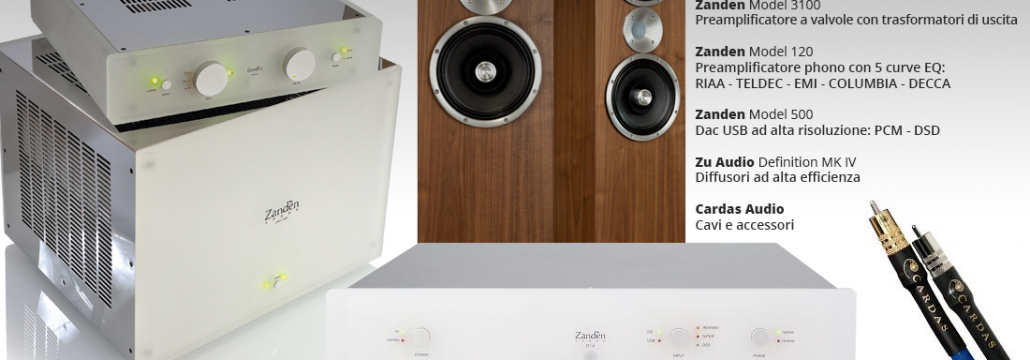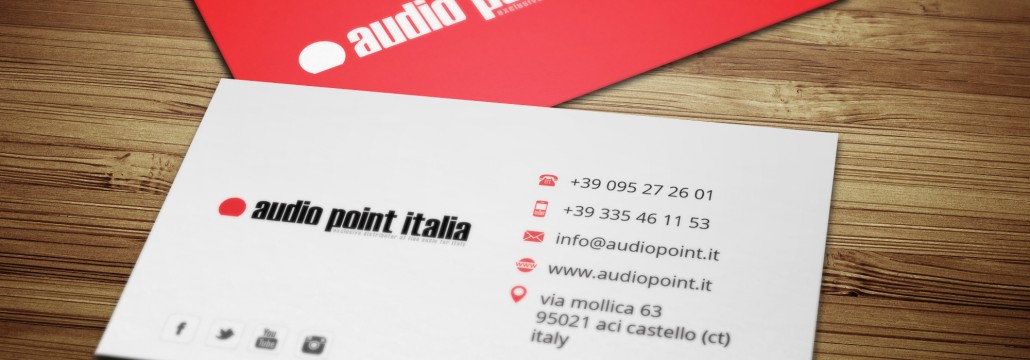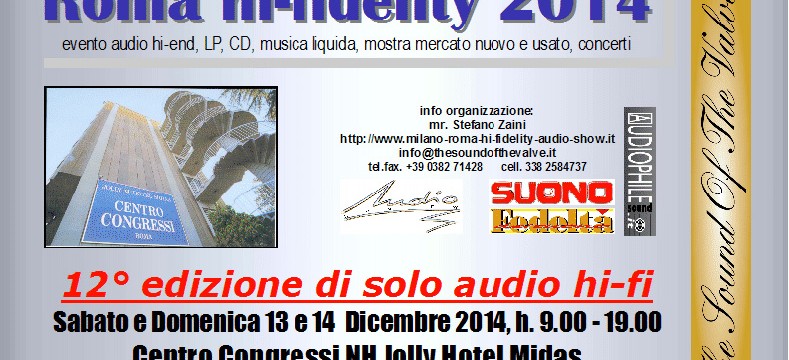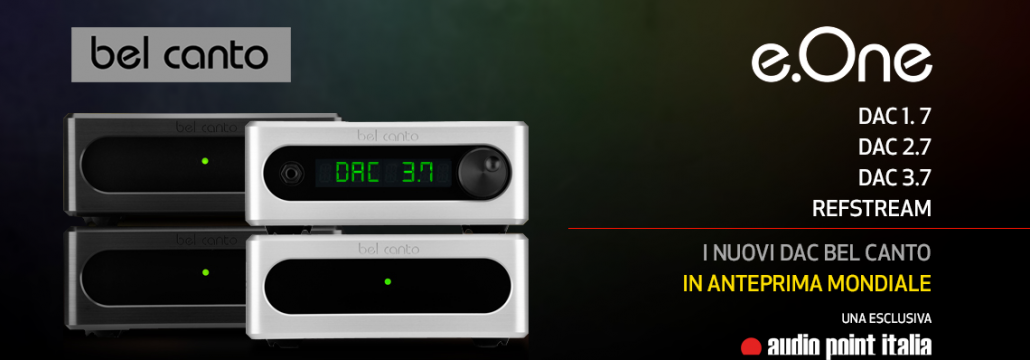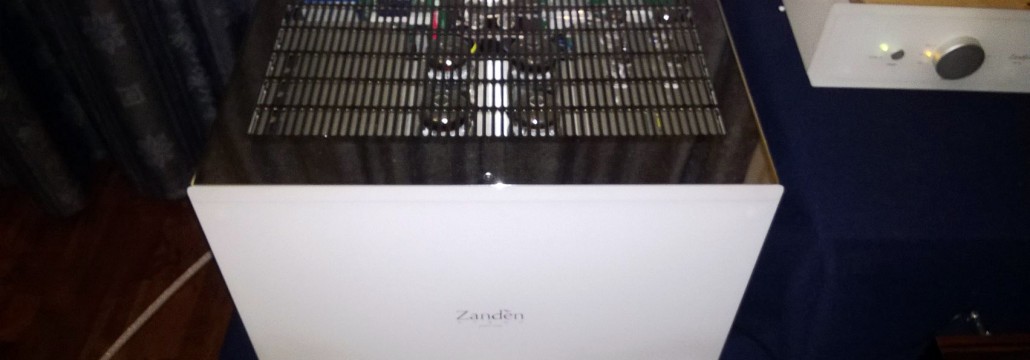Milano Hi Fidelity 2015
Audio Point Italia al Milano Hi-Fidelity 2015.
In dimostrazione:
Zanden Model 8120 – Amplificatore finale con valvole KT-120
Zanden Model 3100 – Preamplificatore a valvole con trasformatori di uscita
Zanden Model 120 – Preamplificatore phono con 5 curve EQ: RIAA, TELDEC, EMI, COLUMBIA, DECCA.
Zanden Model 500 – Dac USB ad alta risoluzione, PCM e DSD
Zu Audio Definition MK. IV – diffusori ad alta efficienza
Cardas – Cavi e accessori
Con la partecipazione, sabato 7 marzo 2015, di Kazutoshi Yamada, ingegnere e fondatore di Zanden Audio.
Come sempre, vi aspettiamo.
The Absolute Sound test: ZANDEN 8120 + 3100
 ZANDEN 8120 POWER AMP AND 3100 LINESTAGE PREAMP
ZANDEN 8120 POWER AMP AND 3100 LINESTAGE PREAMP
Audio Artistry
Equipment report by Jonathan Valin | May 13th, 2014
Categories: Tubed power amplifiers, Tubed preamplifiers | Products: Zanden Audio Systems 3100, Zanden Audio Systems 8120
Zanden 8120 Power Amp and 3100 Linestage Preamp
Ever since I heard Audio Note’s single-ended-triode amps (the Ongaku and the Neiro) back in the late 90s, I’ve been a fan of Japanese artisanal high-end electronics. My trip to Tokyo some years ago only increased my admiration for the Japanese ultra-high end—and my astonishment at its sheer scope, which ranges from some of the most lifelike solid-state gear on the market (such as Technical Brain and BAlabo) to some of the most lifelike tube gear (such as Air Tight, Audio Tekne, and the aforementioned Audio Note SETs).
Zanden 8120
Though none of these very different brands sounds alike, they all have this in common: very high resolution of very low-level musical detail. Indeed, Naoto Kurosawa’s Technical Brain electronics remain my benchmark for the reproduction of low-level musical detail (and for transient speed,
which is intimately tied to the realistic reproduction of the location, texture, and articulation of individual instruments).
The Zanden electronics I’m about to review certainly don’t break the mold. They are extremely fast, extremely high-resolution devices—maybe not Technical Brain fast and high-res, but mighty close. The thing is that, unlike the solid-state Technical Brain gear, the Zanden 8120 stereo amplifier and 3100 preamplifier are tube components, albeit tube components with a distinctive pedigree and a distinctive sound.
Zanden 3100
The unique, patented circuits of Zanden electronics are the work of Kazutoshi Yamada, an electrical engineer who, since founding Zanden in 1980, has literally dedicated his life to amplifier design. Yamada’s single-minded, near-religious devotion to perfecting his art strikes me as typically Japanese, as is his use of the absolute sound as his reference (since 1980 he has acted as an “audio coordinator” for more than 500 live classical and jazz events). All of Yamada’s efforts have been aimed at bridging the still sizable gap between what we hear in actual concerts and what we hear on our stereo systems.
Japanese perfectionism may not be a new story, but for me it is still an inspiring one. Of course, men like Yamada want to earn a living, but they also want to do this “honorably,” by creating the finest examples of their art—and in the Japanese high-end community making high-fidelity components is every inch an art, no matter how much science is applied in the process. Such aestheticism is a refreshing change from the “by-the-numbers” approach of many of the foremost engineers here and in Europe, where products are designed and voiced not in comparison to live music but to computer models, to machine measurements, or, blindly and entirely unscientifically, to each other. (As far as I can tell, so-called “double-blind listening tests” that a few speaker-and electronics-makers swear by bear no resemblance to the actual double-blind tests used in real- world scientific experiments, such as medical drug trials.)
Though it is easy enough to hear the results of Yamada’s aestheticism and perfectionism in the listening, they aren’t fully reflected in the Zanden measurements. Going solely by its numbers Yamada’s 8120 stereo amplifier, for example, appears to be just one more Class AB, KT-120/12AU7-based, 90Wpc tube amp with nothing approaching the spectacular bandwidth and vanishingly low distortion of a Technical Brain TBP-Zero or a Soulution 700. Though it uses direct- coupling between its second and third stages and “minimum” negative feedback, and is said to be fully balanced in operation, these things in themselves are not extraordinary.
Yes, the amp is handsome in a very Japanese, less-is-more way. And, yes, there is a hint that there is something special about its are most attractively and addictively…pliable—to coin a phrase.
Which is to say, sonic differences, large and small, are there for observation, but they aren’t insisted upon. Instead, the Zandens seem to find a dollop of natural musical sweetness in whatever balance a recording, record player, or DAC presents them, making everything not just more listenable but more enjoyable and realistic.
I don’t know how Yamada has accomplished this trick, but it is a helluva neat one, reminiscent (for a lot less money) of “unique circuitry.” (Though he guards the secrets of his circuits closely—to the extent of masking and potting the parts on his triple-shielded circuit boards—Yamada is in print saying that, after decades of research and experiment, he has discovered “correlations between the realistic balance of music and the phase components embedded in the audio signal.” Examples of phase anomalies are inconsistencies in the recording equalization curves of LPs and high- frequency phase distortions caused by the low-pass filters in digital gear. Only by fully accounting for these phase anomalies, says he, can music be reproduced with the “utmost fidelity.”) Still and all, you likely won’t be impressed by reading the 8120’s spec sheet. Same for the tube-rectified, zero-feedback, 5687WB-based 3100 linestage preamplifier.
Once you audition the pair, however, your opinion will change.
This Zanden amplifier and preamplifier are one of those rare combos that somehow manages to be transparent to the sources ahead of it (and the speakers behind it) while at the same time putting a consistently lovely and lifelike spin on timbres. This is not to say that the Zandens are overtly “dark,” “warm,” “beautiful,” “liquid,” or “rich” sounding. They are not inherently any of these things. Like so much other top-rank Japanese audio gear, the Zanden pair is essentially neutral in balance —neither “bottom up” (i.e., dark) nor “top down” (i.e., bright), to quote Raidho’s Michael Børresen yet again. As a result, differences in recording, speaker, and source balance are always clearly reproduced by the Zanden duo. Not only do RCAs sound like RCAs, Deccas like Deccas, Mercs like Mercs, but the same specific differences in miking and mastering among individual RCAs, Deccas, and Mercurys that one hears through the highest-transparency, highest-resolution gear are also clearly reproduced by the Zandens. And yet, at the same time, the 8120 and 3100 what Edwin Rijnveld managed to do in his swooningly beautiful-sounding yet startlingly realistic Siltech SAGA System.
I’m mentioning the SAGA electronics in the same breath with the Zanden 8120 and 3100 because they share several other qualities beyond a see-into transparency that is not bought at the price of lovely natural timbre. For one, like the SAGA, the Zanden duo doesn’t sound “tubey” in the fat, old- fashioned, loads-of-second-order-harmonic-distortion sense. It is quick and clean and quiet and quite incredibly finely detailed, with superbly defined bass (perhaps even better here than the Siltech).
For example, in Britten’s Young Person’s Guide (from Reference Recording’s Britten’s Orchestra) at the close of the Allegro maestoso that announces the majestic Purcell theme upon which the variations that follow are based, the bass drum is struck sharply—to help signal the end of the thematic exposition and the start of the variations. Provided your electronics don’t stumble over transients or muddy up the bottom octaves, this dramatic percussive punctuation mark should sound crisp, clean, and exciting—with beater, drumhead, and shell clearly audible in series.
What may not be clear—or as powerful—is the drum roll that follows this fortissimo thwack, like a little flourish as the curtain is raised. Some electronics—particularly some tube electronics, and particularly in the bass octaves—need figuratively to “catch their breath” after large expenditures of dynamic energy such as that initial drum thwack. As a result, notes that follow hard upon in the same register can sound a bit smeared or compressed, kind of like the electronic version of woofer “overhang.”
Despite the fact that they’re powered by tubes, the Zanden 8120 and 3100 have none of this overhang-like effect. The drum roll is as clean and clear and distinctly full and natural in timbre as the fortissimo thwack that preceded it. It wasn’t all that many years ago that tube gear simply
couldn’t do a very dynamic sequence like this one—which flies from fortissimo to fortissimo in the space of two notes—without audible losses of leading-edge clarity, energy, focus, and color.
Again, on an assemblage of deep-going instruments such as Gonzalo Rubalcaba’s Fender Rhodes, Mario Parmisano’s synths, Ernie Adams’ drums, Anthony Jackson’s electric bass, and Al Di Meola’s own collection of dumbeks and stomp boxes on “Zona Desperata” from Flesh on Flesh, a good deal of tube gear would be flummoxed trying to keep track of each musical line without smearing them together, and simply tripping over its shoestrings and falling face forward on really deep notes (and this track goes deep). Once again, the Zanden duo simply sails through this torture test, keeping musical lines clean and uncompressed in dynamic while also preserving intact the full-bodied timbres and complex articulations of every instrument and going right through the floor on the temblor-like deep bass notes. Once again, this is not typical tube-amp behavior.
If you think I’m concentrating on the bass because the Zandens fall short everywhere else, think again. These are full-range electronics, whose virtues extend from top to bottom. One listen to the in-the-room-with-you realism they elicit on the lead vocal and potted-in harmony and backup vocals (all Joni, actually) from Joni Mitchell’s “Help Me” will prove that these electronics are capable of the same outstanding clarity, speed, energy, and truth to timbre in the midband that make them so stellar in the bass. And their string and wind tone on something like the Reiner/CSO Pictures at an Exhibition [Analogue Productions], which in the wrong hands can sound a little gruff, is to die for— a further instance of the Zandens’ remarkable ability to find the natural musical sweetness of any recording, no matter how it was recorded, what dynamic level it is played back at, or how busy the instrumentation is.
Although the Zandens are a little less forgiving in the treble than they are in the midband and the bass—which is to say that they won’t sweeten or smooth away the bright edge of a too-closely- miked piano, piccolo, flute, or cymbal—they don’t exaggerate such miking/mastering flaws. They simply report them. On good recordings, their treble can be startlingly realistic—as fast, clear, lovely, and finely resolved as their midband and their bass. And when it comes to soundstaging— reproducing the ambient space in which a recording was made (along with the three-dimensional disposition of the ensemble within that space)—this Zanden gear is very nearly peerless.
Of course, Zanden electronics have always been famous for their spaciousness (a quality that Yamada has consistently sought to capture in his designs), but the 8120 and 3100 are high among the most spacious I’ve heard, reproducing soundstage depth and width (both wall-to-wall and among individual instruments) with just a touch more air and room than virtually anything else I’ve heard. On the right recordings, this is quite a spectacular effect.
No, Zanden’s new stereo amp and linestage preamp don’t have the seemingly inexhaustible power and sheer whomp of Soulution’s latest solid-state gear (you can run the Zandens out of steam at very loud levels—after all 90 watts is 90 watts); nor do they have all the density of power-range and midband tone color of Siltech’s gorgeous-sounding SAGA System; nor do they have all the astonishing resolution and transient speed of Technical Brain TB-Zero line or Constellation’s Performance Series; nor do they have all the bloom and 3-D depth of image of Audio Research Reference 10 electronics. But…they come so close to these exemplars for so much less money that I wouldn’t want to quibble about the differences.
When you take what they do do—which is reproduce all recordings with an almost magical ear to what makes music sound sweet and lifelike—and when you consider that they do this from top to bottom (simply outstanding bass for tube electronics—indeed, for any electronics) and when you throw in their sui generis soundstaging, I don’t see how the Zanden 8120 and 3100 can earn anything but my highest recommendation. I consider them reference-quality (they’re outstanding matches for Raidho D-1s, BTW), and given that they cost one-third to one-half of what my other references cost, I also consider them ultra-high-end bargains. Go listen for yourselves.
Link articolo: http://www.theabsolutesound.com/articles/zanden-8120-power-amp-and-3100-linestage-preamp/
Roma Hi Fidelity 2014
Roma Hi Fidelity 2014 si è appena conclusa. Due giorni di Hi Fi, di musica e soprattutto di incontri con vecchi e nuovi appassionati.
Ci conforta, come sempre, incontrare tante persone. Alcune conosciute, altre nuove. Ed è la più grande fortuna di chi ha scelto di fare della propria passione il proprio lavoro.
Vi ringraziamo davvero di cuore per il tempo che avete trascorso con noi, dimostrazione di sincera stima e interesse. Vi diamo appuntamento alle prossime occasioni, che saranno annunciate sia sul nostro sito che sulla nostra pagina Facebook.
Adesso è l’ora di rimetterci in viaggio e ripartire con un pizzico di entusiasmo in più.
Grazie ancora e arrivederci a presto!
Galleria immagini (Zanden, Cardas, Zu Audio, Bel Canto Design):
Audio Point Italia al 12° Roma Hi-Fidelity, manifestazione High End: 13 – 14 dicembre 2014
Siamo nuovamente in viaggio per incontrare tutti gli appassionati, vecchi e nuovi. Per ascoltare insieme a voi le nostre proposte, per scambiarci le nostre sensazioni di ascolto e prestare piacevole attenzione ai vostri commenti e suggerimenti.
Audio Point Italia sarà presente al Roma Hi Fidelity, meglio conosciuto come “Roma High End”, in una sala da 120 mq, con il seguente impianto:
Amplificatore finale: Zanden Model 8120 (2×100 watt con valvole Kt120)
Preamplificatore: Zanden Model 3100 (preamplificatore a valvole ad alto guadagno con trasformatori di uscita)
Diffusori: Zu Audio Definition MK IV
Sorgente digitale: DAC BelCanto 3.5 VB MkII + Lettore Digitale BelCanto CD2
Cavi: Cardas
La manifestazione Roma Hi-Fidelity si terrà nei giorni di sabato 13 e domenica 14 2014 presso:
Hotel NH Roma Midas
Via Aurelia, 800
00165 Roma
Nuovi DAC Bel Canto 1.7 – 2.7 – 3.7 e REFStream
Vi presentiamo in anteprima mondiale i nuovi DAC Bel Canto con i rispettivi prezzi al pubblico:
e.One DAC1.7 : Euro 1.495,00
24-bit 192kHz 120dB Dynamic Range Dual-Differential DAC, Ultra Clock(tm) and 24-Bit Volume Control, Balanced I/O, 5 Digital Inputs, 24-bit 192kHz USB, 1/4″ Front Panel Headphone Output with 300MA High Current Low Impedence dedicated amplifier, 4-Character Alphanumeric Display, Remote.
e.One DAC2.7 : Euro 2.495,00
24-bit 192kHz 124dB Dynamic Range Dual-Differential DAC, Ultra Clock(tm) and 24-Bit Volume Control, Balanced I/O, 5 Digital Inputs, 24-bit 192kHz USB, 1/4″ Front Panel Headphone Output with 300MA High Current Low Impedence dedicated amplifier, 8-Character Alphanumeric Display, Remote.
e.One DAC3.7 (VBL incluted): Euro 4.495,00
2 chassis DAC system, 24-bit 192kHz 126dB Dynamic Range Dual-Differential DAC, Ultra Clock(tm) and 24-Bit Volume Control, Balanced I/O, 5 Digital Inputs, ST Glass-Fiber input, Analog input, 8-Character Alphanumeric Display, Remote; descrete Power cable; Power supply VBS Highly-Regulated Power, 100 Joules of Energy Storage, 100 dB of isolation Below 100Hz.
e.One REFStream : Euro 2.495,00
High perfomance Asynchronous ultra-low noise Network Audio Renderer, Optimized playback for all formats; FLAC, ALAC, AIFF, WAV, MP3, DSD Inputs Ethernet, outputs AES, RCA, STfiber.
Sintonie 2014: prima giornata
Oggi prima giornata della famosa manifestazione.
Vi ringraziamo per esserci venuti a trovare e a condividere bellissimi momenti di genuina passione.
Vi aspettiamo domani, sabato 18 ottobre, per la seconda ed ultima giornata. Potrete ascoltare in anteprima mondiale, presso le nostre sale, il nuovo DAC Bel Canto Design 2.7
Ed inoltre: il finale Zanden 8120 (KT120), pre e pre phono Zanden 1300 e 3100. L’integrato Leben CS 300 XS e molto altro. Tutto cablato con cavi Cardas Audio serie Clear.
- Sintonie 2014: Zanden
- Sintonie 2014
- Sintonie 2014
- Sintonie 2014: Zu Audio – Bel Canto – Leben
- Sintonie 2014: Zu Audio – Bel Canto – Leben
- Sintonie 2014: Bel Canto – Leben
- Sintonie 2014: Zu Audio – Bel Canto – Leben
- Sintonie 2014: Zu Audio
- Sintonie 2014
- Sintonie 2014: Zu Audio – Bel Canto – Leben
- Sintonie 2014: Zanden
- Sintonie 2014: Zanden
- Sintonie 2014: Bel Canto
- Sintonie 2014: Leben

